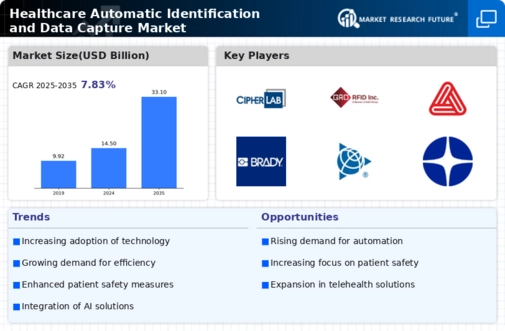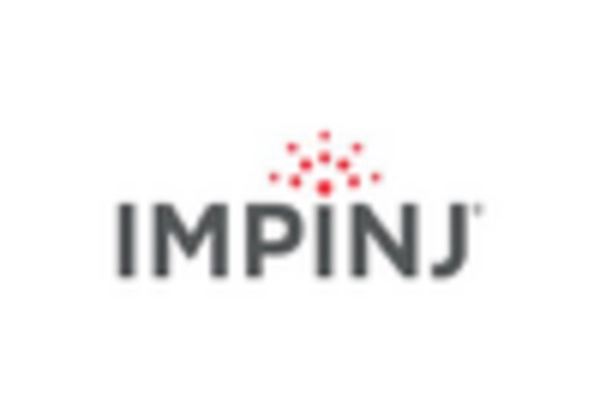Rising Focus on Patient-Centric Care
The shift towards patient-centric care is significantly influencing the Healthcare Automatic Identification and Data Capture Market. Healthcare providers are increasingly recognizing the importance of personalized care and the role that accurate data plays in achieving this goal. Automatic identification technologies enable healthcare professionals to access real-time patient information, thereby enhancing the quality of care delivered. This focus on patient outcomes is driving the adoption of data capture solutions that facilitate better communication and coordination among healthcare teams. As patient-centric models become more prevalent, the demand for automatic identification and data capture technologies is expected to grow, potentially leading to a market increase of around 9 percent over the next few years.
Regulatory Compliance and Standardization
Regulatory compliance is a critical driver in the Healthcare Automatic Identification and Data Capture Market. Healthcare organizations are mandated to adhere to stringent regulations regarding patient data management and safety. The implementation of automatic identification technologies aids in meeting these compliance requirements by ensuring accurate tracking and documentation of medical supplies and patient information. For instance, the adoption of barcoding and RFID systems facilitates adherence to standards set by regulatory bodies, thereby reducing the risk of penalties and enhancing operational efficiency. As healthcare providers increasingly prioritize compliance, the demand for automatic identification solutions is expected to rise, potentially leading to a market expansion of approximately 8 percent annually.
Growing Demand for Efficient Inventory Management
The Healthcare Automatic Identification and Data Capture Market is experiencing a notable surge in demand for efficient inventory management solutions. Hospitals and healthcare facilities are increasingly adopting automatic identification technologies to streamline their inventory processes. This shift is driven by the need to reduce operational costs and minimize waste. According to recent data, healthcare organizations that implement these technologies can achieve inventory accuracy rates exceeding 95 percent. This efficiency not only enhances patient care by ensuring the availability of necessary medical supplies but also contributes to significant cost savings. As a result, the market for automatic identification and data capture solutions is projected to grow, with an estimated compound annual growth rate of around 10 percent over the next five years.
Increased Investment in Healthcare Infrastructure
Investment in healthcare infrastructure is a significant driver of the Healthcare Automatic Identification and Data Capture Market. Governments and private entities are allocating substantial resources to enhance healthcare facilities and services. This investment often includes the integration of advanced technologies, such as automatic identification and data capture systems, to improve operational efficiency and patient care. Enhanced infrastructure not only supports the implementation of these technologies but also encourages innovation within the healthcare sector. As a result, the market for automatic identification solutions is anticipated to expand, with growth rates projected to reach approximately 11 percent as healthcare systems evolve to meet the demands of modern patient care.
Technological Advancements in Data Capture Solutions
Technological advancements play a pivotal role in shaping the Healthcare Automatic Identification and Data Capture Market. Innovations such as advanced barcode scanning, RFID technology, and mobile data capture devices are revolutionizing how healthcare providers manage information. These technologies enhance the speed and accuracy of data collection, which is essential for effective patient care and operational efficiency. The integration of artificial intelligence and machine learning into data capture solutions further optimizes processes, allowing for real-time data analysis and decision-making. As these technologies continue to evolve, the market is likely to witness a robust growth trajectory, with projections indicating a potential increase in market size by over 12 percent in the coming years.

















Leave a Comment